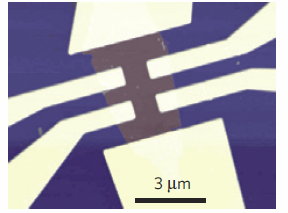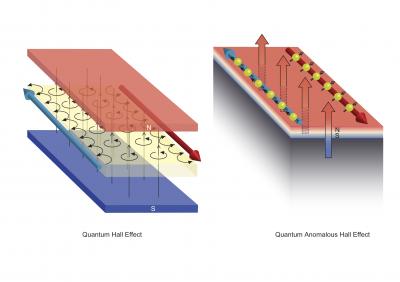Eliminating transmission power loss, a major power-grid solution
August 23, 2012

The active area of magnetic topological insulator (dark gray) is 3 microns across and only 70 atoms thick. The blue background is an insulating gate dielectric and the yellow regions are metallic electrodes. (Credit: RIKEN)
Researchers at RIKEN and the University of Tokyo have demonstrated a new material that promises to eliminate loss in electrical power transmission, based on a “magnetic topological insulator” — a material that behaves as an insulator in its interior while permitting the movement of charges on its surface.
The transmission of power consumes more than 10% of all energy being produced, according to some estimates.
The work by the RIKEN/UT collaboration is closely related at a landmark discovery from the 1980s, the “quantum Hall effect.” That effect is known to produce dissipationless (no-loss) electrical wires of cables, but it requires large, cumbersome magnets to produce fields 100,000 larger than the earth’s magnetic field for its operation.

A depiction of the quantum Hall effect (left) and the quantum anomalous Hall effect (right) (credit: RIKEN)
The RIKEN/UT collaboration circumvented this difficulty by using an exotic type of semiconductor predicted to exhibit a similar effect. In contrast to the quantum Hall effect, this effect, known as the “quantum anomalous Hall effect,” stems from the semiconductor’s own magnetization rather than from an external one.
At the heart of this new phenomenon is the interaction between magnetic ions and the topological insulator’s current carrying particles (known as Dirac fermions), which behave as if they have zero mass.
The devices produced by the RIKEN/UT team are a robust “proof of principle,” demonstrating that this new type of dissipationless transport can be harnessed in prototype transistors.
Currently, it requires cryogenic conditions, but improvements in materials design promise to improve the stability of the magnets, making it possible to operate them at higher temperatures, the researchers say.
By doing away with magnetic fields — and, in the future, cryogenic cooling — these new magnetic topological insulators may represent the most efficient path to modernizing the power grid by eliminating loss in energy transfer.